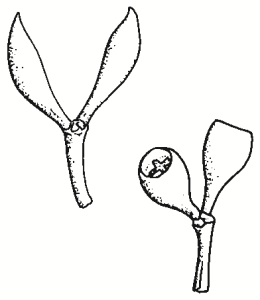Family:
Myrtaceae
Eucalyptus microcarpa
Grey Box
Other Names: Western Grey Box, Gum-topped Box.
First Nations Name(s):

Name Origin:
microcarpa — from Greek micros, small, and carpos, fruit, referring to small fruit.
Regional Subspecies:
Similar Species:
Often confused with White Box (E. albens). Grey Box has greener and narrower leaves than White Box, and smaller buds and fruit.
Occurrence:
Regional:
Widespread west of the Hume Highway on lower slopes and plains country.
Australia:
Qld, NSW, Vic, SA.
Habitat:
Grassy woodland on moderately fertile loamy soils.
Habit:
Tree to 25 m high. Open crown of dull olive-green leaves. Grey, fibrous-flaky ‘box’ bark with whitish patches, upper branches smooth-barked.
Site Preference:
Heavy loamy soils. Tolerates moderately alkaline soil, frost, wind, infrequent flooding and extended dry periods.
Characteristics:
Long-lived. Moderate growth rate.
Flowering:
White, Feb-Jun. Flowers freely each year.
Seed Collection:
Throughout year, as seeds generally retained. Good crops may be irregular.
Propagation:
From seed (± 729 seeds per gram).
Regeneration:
From seed, particularly in absence of competitive exotic grasses or weeds, during wet summers. Coppices vigorously from low stumps, and regrowth is long-lived. Establishes well when direct seeded.
VALUES:
Shade & Shelter:
Useful medium-level cover in windbreaks. Good shade due to spreading crown.
Land Protection:
Useful in gully erosion control behind fibrous-rooted understorey species.
Wildlife:
Excellent habitat. Flowers are a food source for Sugar Gliders, Squirrel Gliders, native birds and insects. Insect-eating birds attracted. Hollows are nesting and refuge sites for native birds and mammals. Critical habitat for the Grey-crowned Babbler, Stone Curlew and goannas.
Fuel:
Very good.
Timber:
Pale, very durable, tough and strong. Density about 1100 kg/m3. Used for posts, poles, fencing and heavy construction. Interesting furniture timber, although difficult to work.
Ornamental:
No outstanding features, although may be suitable for larger gardens and parks.
Other:
Leaves produce a range of dyes depending on mordants used.
